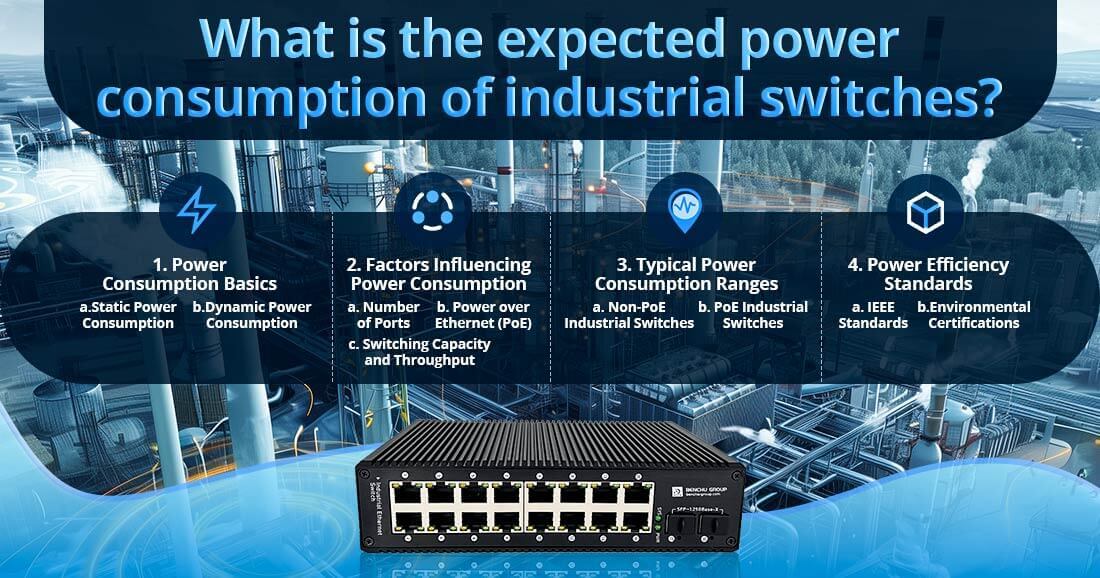
The expected power consumption of industrial switches can vary widely based on several factors, including the switch's specifications, the number of ports, supported features (like Power over Ethernet), and operational environment. Here's a detailed description of the power consumption aspects of industrial switches:
1. Power Consumption Basics
a. Types of Power Consumption
--- Static Power Consumption: This refers to the baseline power required to operate the switch when it is idle or under low traffic conditions. It typically includes the power needed for the switch’s internal components, such as the CPU, memory, and cooling systems.
--- Dynamic Power Consumption: This varies based on the load and the number of active ports. As more devices are connected and data is transmitted, the power consumption increases due to higher processing demands.
2. Factors Influencing Power Consumption
a. Number of Ports
--- Port Count: Generally, the more ports an industrial switch has, the higher the power consumption. A typical industrial switch may have anywhere from 5 to over 48 ports. Larger switches may consume more power due to the additional hardware required to support more connections.
b. Power over Ethernet (PoE)
--- PoE Capability: If the switch supports PoE, it will consume more power to deliver electrical power along with data to connected devices (like IP cameras or sensors). The total power consumption can increase significantly, depending on the number of PoE devices and their power requirements. For instance, PoE can provide up to 15.4W per port (IEEE 802.3af), while PoE+ can deliver up to 30W, and PoE++ (IEEE 802.3bt) can provide up to 60W or even 100W per port.
c. Switching Capacity and Throughput
--- Performance Specifications: Higher switching capacities, which can manage more data traffic, often require more power. For instance, switches designed for high throughput (like Gigabit or 10 Gigabit Ethernet) typically consume more power than standard Ethernet switches due to the increased processing power needed to handle data at these speeds.
3. Typical Power Consumption Ranges
a. Non-PoE Industrial Switches
--- Typical Consumption: Non-PoE industrial switches with 5 to 24 ports typically consume between 10W to 50W, depending on the model and operational load. For instance, a 16-port switch may consume around 20W under typical conditions.
b. PoE Industrial Switches
--- Higher Consumption: For PoE-capable switches, the power consumption can range significantly. A small 8-port PoE switch might consume around 50W to 100W, while larger switches with 24 or more ports can exceed 300W, especially if multiple devices are powered through PoE.
4. Power Efficiency Standards
a. IEEE Standards
--- Energy Efficiency: Many industrial switches are designed to comply with energy efficiency standards, such as IEEE 802.3az (Energy Efficient Ethernet), which reduces power consumption during low-traffic periods. This can help mitigate overall power usage, making the switches more sustainable and cost-effective.
b. Certifications
--- Environmental Certifications: Look for switches with certifications like Energy Star or other energy efficiency labels, which indicate lower power consumption and environmentally friendly designs.
5. Estimating Total Power Requirements
a. Calculation Considerations
Total Power Calculation: To estimate total power consumption for an industrial switch setup, consider the following:
--- Base power consumption of the switch (static).
--- Additional power for each PoE device connected (if applicable).
--- Power overhead (typically an extra 20-30% to account for power spikes or inefficiencies).
b. Example Calculation
For a 24-port PoE switch:
--- Base Power: 60W (for the switch itself).
--- PoE Power: If 12 ports are used with PoE devices averaging 15W each, that adds 180W.
--- Total Estimated Power: 60W (switch) + 180W (PoE devices) = 240W.
--- Including Overhead: 240W + 30% (72W) = 312W total power requirement.
6. Conclusion
The expected power consumption of industrial switches varies widely based on their design, features, and operational load. Understanding the factors influencing power consumption—such as the number of ports, PoE capabilities, and switching capacity—can help in selecting the right switch for specific applications while ensuring efficient energy use. Proper estimation of power requirements is crucial for system design and infrastructure planning, particularly in environments where energy efficiency and operational costs are critical considerations.